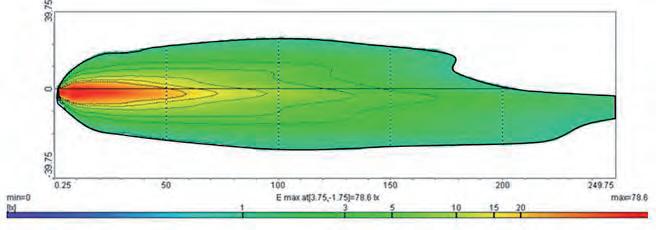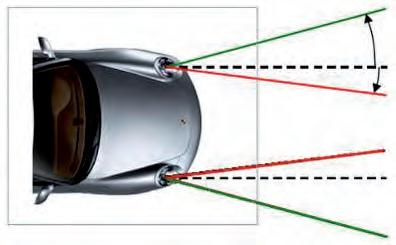
9 minute read
Lighting
9.4 Lighting
To ensure good visibility at night and a high level of road safety, the 911 Carrera (991) models are equipped with powerful Bi-Xenon main headlights as well as front light modules with daytime running lights, position lights and direction indicator lights in LED technology. The tail lights are also designed entirely using LED technology.
Light functions
Standard equipment: Bi-Xenon (dipped beam) Optional: Bi-Xenon with cornering light and PDLS (Porsche Dynamic Light System)
Figure 9_29_11 shows the LED side marker light in light guide technology.
Figure 9_31_11 shows the LED daytime running light in light guide technology (SMD).
Figure 9_30_11 shows the LED direction indicator.
9_29_11
9_31_11
9_30_11 Electrics and electronics 9

Lamp type D3S (mercury-free) 9_27_11
Electrics and electronics 9 !

AFS is acronym for speed-sensitive headlight range control. English defintion is, Adaptive Forward Lighting (In German means Automatische Fahrlicht Steuerung). Porsche Dynamic Light System
The PDLS (Porsche Dynamic Light System) optionally available for the 911 Carrera models comprises a swivelling PDLS module for the dynamic cornering light and speed-sensitive headlight range control (AFS). It operates with a projection system (PDLS is active when the light switch is in "AUTO" position). The projection system includes a rotating drum with various contours for modifying the light/dark border of the light as well as a lens. The headlight can be set to different light modes, e.g. country road light and highway light, by way of the drum and changes in the light output. An adverse weather function will also be implemented for the first time. A halogen auxiliary high beam light is also included in the PDLS to supplement the Xenon high beam light, which already illuminates the area in front of the vehicle particularly effectively due to the drum position with the cover open fully and higher light intensity.
Light functions (PDLS) Country road light/dipped beam

9_33_11
The country road light/dipped beam of the PDLS ensures better illumination of the surroundings and better range compared with the dipped beam of the previous Bi-Xenon headlight. This is achieved by adapting the light cone by way of a special anti-glare contour in such a way that there is no glare for oncoming traffic.
Motorway light (2-stage)


9_34_11
The highway light increases the range of vision on multi-lane roads without blinding oncoming traffic. Thanks to adapted light output and distribution, it provides optimum illumination of the road without increasing glare for the traffic in front. It increases the driver's range of vision by up to 164 ft (50 meters) compared with the conventional dipped beam.
The highway light is automatically activated if the vehicle speed exceeds 68 mph (110 km/h) for more than 33 seconds or above 81 mph (130 km/h) without any preconditions. It is switched off immediately without any other conditions at speeds of less than 50 mph (80 km/h). It must be noted that the adapted light distribution of the highway light is not activated due to legal requirements in the USA (and in all countries where headlights Code 553 are installed). Activation of the AFS function highway light takes place in two stages. Stage 1: Increase in power output of Xenon lamp from 35 W to 37 W and light distribution like for country road light. Stage 1 is activated as from a speed of 56 mph (90 km/h) after a certain period of straight-ahead driving. Stage 2: Increase in light distribution with maintained increase in power output. Stage 2 is activated from 68 mph (110 km/h). Stage 2 is activated immediately as from 81 mph (130 km/h), also without previous activation of stage 1. Electrics and electronics 9
Electrics and electronics 9 High beam, incl. halogen auxiliary high beam light


9_35_11
High beam is used to extend the illumination range of the road in front of the vehicle. High beam can be activated only if dipped beam is active. The auxiliary high beam light (separate halogen light source) is always activated when high beam is active. The lifting motor (switching shutter) is activated in the case of Bi-Xenon headlights and the drums on AFS headlights.
Adverse weather or fog light function

9_36_11
The adverse weather or fog light function reduces the risk of the driver being blinded in poor weather conditions, e.g. heavy snowfall or fog, by swivelling the left headlight outwards by 8° and setting a horizontal light distribution. The power output is also reduced to 33 W and the cornering light is deactivated. Together, these measures reduce the amount of light reflections, both from the road surface and due to fog. The function is activated when the rear fog light is switched on and at speeds between 6 and 44 mph (10 and 70 km/h).
Cornering light


9_37_11
The dynamic cornering light is activated as from a speed of > 2.2 mph (3.6 km/h). The light control swivels the headlights to the side by up to 15° (15° for light unit on inside of bend, 7.5° for light unit on outside of bend), depending on the steering angle and vehicle speed in the bend.
The light beam is therefore projected onto the road to a maximum range without blinding oncoming traffic. Consequently, when driving in the dark on twisting roads, the driver can see which way the road is going and can detect any obstacles much earlier and adapt his/her driving style accordingly. This feature also provides a significant increase in safety when driving on country roads and in extended highway bends by optimally illuminating bends. Sensors continuously measure the driving speed, lateral acceleration and steering angle, and use this information to calculate the bend path. A control unit uses the data it receives to determine the best angle for controlling the dynamic cornering light.
The cornering light also remains active when the high beam is switched on, improving the driver’s visibility. Electrics and electronics 9
A second cornering light characteristic is available for Sport mode. This function can be activated/deactivated by coding with the PIWIS Tester II /Codings –Adaptations/Customer-specific settings.
Dynamic cornering light adjustment = 15° on inside of bend (green lines) and 7.5° on outside of bend (red lines).
Electrics and electronics 9


9_38_11

9_39_11

9_40_11

9_41_11 Tail lights
The tail lights are designed completely in LED technology and include a rear fog light. Their very short response times improve active safety. In the event of very heavy braking or an emergency stop, the brake lights flash to warn the following traffic. If the vehicle is braked to a standstill, the hazard warning lights are also activated automatically.
The following lights are designed using LED technology: • Side marker lights (see Fig. 9_38_11) in LED and light guide technology • Brake lights (see Fig. 9_39_11) • Direction indicators lights with side marker light (see Fig. 9_40_11) in LED and light guide technology • Back-up light with side marker light (see Fig. 9_41_11)
Rotary light switch
The rotary light switch is used to control various light functions: • Switch lights on/off • AUTO= Automatic headlights • Parking light • Dipped beam/driving light • Rear fog light
Rain function
9_42_11
The headlights are switched on automatically after five seconds of continuous wiper operation. If the wipers have not been used for approx. 4 minutes, the headlights are switched off.
Communication with the front-end electronics takes place via the LIN data bus and a redundant (hard-wired) cable that is directly connected to the front-end electronics and guarantees light functions via the rain-light-moisture sensor in the event of LIN failure.

The automatic headlights function (standard equipment) is a new comfort function. The headlights (dipped beam) are switched on and off automatically depending on the ambient brightness. The automatic headlights function also controls the daytime running lights, dipped beam, automatic Welcome Home lights and equipmentdependent dynamic cornering lights. The automatic headlights function is activated by setting the light switch to "AUTO" position. The new automatic headlights function also increases comfort. The sensor for the automatic headlights function is accommodated in the mirror base of the interior mirror and automatically switches from daytime running lights to dipped beam when it is getting dark and when driving through tunnels, for example, if the rotary light switch is in "AUTO" position. The "AUTO" automatic headlights function also activates the automatic Welcome Home function (Coming-home/Leaving-home).
Light design package
A light design package (LED light package for the interior) with ambient lighting is optionally available to further enhance comfort and day-to-day usability. As well as adjustable dimmed continuous lighting in the overhead operating console, the package includes additional high-intensity LED orientation lights in the doors (storage compartment lighting), in the rear and in the footwells. Electrics and electronics 9
Electrics and electronics 9 Hazard warning flashing/accident flashing

The hazard warning and accident flashing functions are essentially similar. Hazard warning flashing provides a warning around the whole vehicle and is activated manually by way of the hazard warning light button. Accident flashing is activated automatically in the event of a vehicle accident in order to alert other vehicles. Both functions have priority over the direction indicator function. In the event of a lamp failure, the flashing frequency of the direction indicator lights does not change. In contrast, the feedback lamps on the instrument cluster and in the hazard warning light button flash much more quickly. The US variant features flasher repeaters and side marker lights. The duty cycle is lower for accident flashing than for hazard warning flashing. Accident flashing can be deactivated by switching the ignition off and then back on again.
Fig. 9_43_11 shows the activated high-level brake light. Table: Equipment scope of interior lights: LED/incandescent lamps

9_43_11
Type LED
Equipment scope Interior and reading light in the overhead operating console Orientation light in the overhead operating console Make-up lights in the sun visors Ashtray lighting Ignition lock light Incandescent lamp Footwell lighting Glove compartment light Safety and exit lighting Luggage compartment lighting







